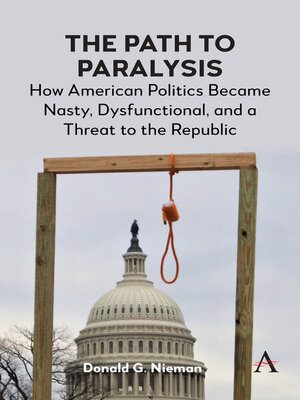The Path to Paralysis
ebook ∣ How American Politics Became Nasty, Dysfunctional, and a Threat to the Republic
By Donald G. Nieman

Sign up to save your library
With an OverDrive account, you can save your favorite libraries for at-a-glance information about availability. Find out more about OverDrive accounts.
Find this title in Libby, the library reading app by OverDrive.



Search for a digital library with this title
Title found at these libraries:
| Library Name | Distance |
|---|---|
| Loading... |
How did the world's oldest democracy lose its mojo? How did we get to a point where we face existential crises like climate change yet leaders can't agree that there's a problem let alone develop solutions? Political leaders bear some of the responsibility. Newt Gingrich, Sarah Palin and Donald Trump, to name a few, have shattered political norms and transformed our politics into a free-for-all in which personal attacks, appeals to bigotry and fear, disregard for truth, and disdain for governing have become the norm. But they are more a symptom than the cause. The Path to Paralysis examines changes in political culture during the past 60 years – conflict over race, religion and gender; wrenching economic changes and growing concentration of wealth; the end of the Cold War; hardening regional divisions; and dramatic changes in communications – that made Donald Trump possible, if not inevitable. Long in the making, these cross-currents came together in the early 21st century – as the United States experienced the deepest recession since the 1930s and elected its first Black president – to create the perfect storm. The result was toxic and deeply polarised politics that threatened the existence of constitutional government.
|Much has been written about political polarisation in the United States, but no one has examined it through the lens of recent U.S. history. There is nothing deterministic about how we became polarised, and it happened more recently than many think. To fully understand the problem, we must take the long view, the perspective provided by history, with its attention to change over time and the role of contingency. That's what The Path to Paralysis does.
The book illuminates the broad forces that have shaped and reshaped American society and politics since the mid-1960s: the shift from an industrial to an information economy that produced economic inequality not seen since the 1920s; dramatic, unsettling changes in gender and sexuality; sharp conflict between those who embrace the culture of personal freedom that was a legacy of the 1960s and politically mobilised White evangelicals; persistent racial discord that transformed Southern politics and shattered the New Deal coalition; and dramatic changes in communication that transformed broadcasting into narrowcasting, creating alternate news and truths.
These developments had their origin in the late 1960s and have generated sharp political conflict for six decades. But they didn't overwhelm the system until the 21st century. Ronald Reagan moved American politics to the right, but Republicans and Democrats forged compromise on issues as diverse as economic policy, civil rights, and immigration. After the culture wars of the 1980s and 1990s, Bill Clinton and George W. Bush tacked to the centre and sought bipartisan solutions to issues like welfare, education and immigration. Sharp conflict and governance were compatible.
The tipping point was the election of the nation's first Black president and the economic collapse he inherited. Fault lines of religion, region, gender, sexual orientation, class, education and, especially, race widened. People chose sides and identified enemies, the number of true swing voters shrunk, fewer states and congressional districts were competitive, the two major parties became more monolithic, and appeals to the base drove strategy and what passed for policy. It was an...







